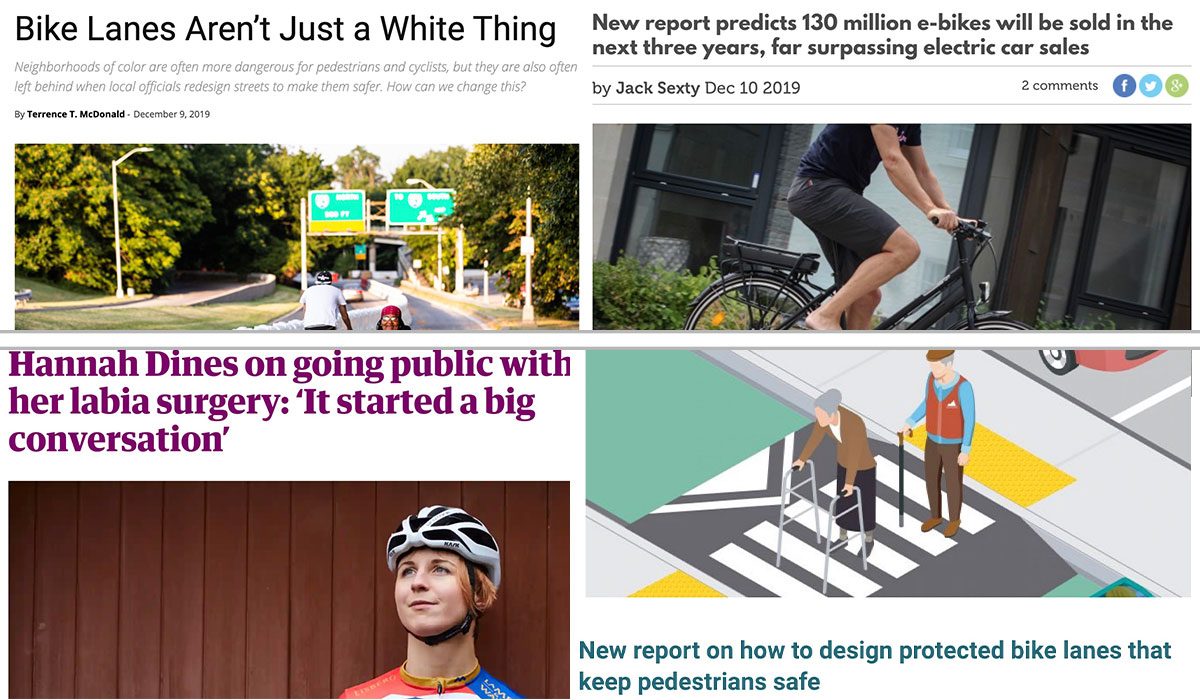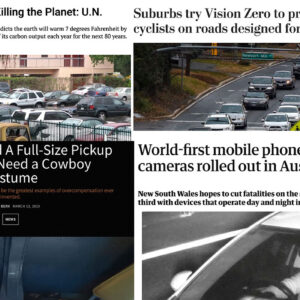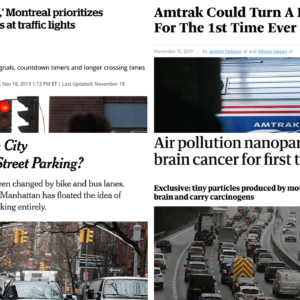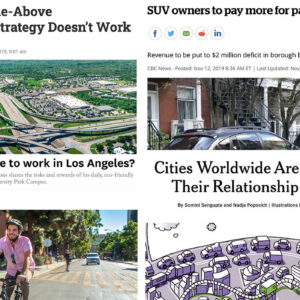Here are the most noteworthy things we came across in the past seven days.
But wait…
This week’s Monday Roundup is brought to you by Endurance Cycling Studio and Physical Therapy. Winter is a great time to work on biomechanics and get more efficient on and off the bike. Mention BikePortland and get 10% off their December Bike Fit Special. EndurancePDX.com.
OK, your roundup is below:
Women and safety: Buried in this story on cycling’s persistent gender gap is how the number of female riders skyrocketed in New York City on two streets after protected bike lanes were installed.
Helmet research: Since I have a feeling we’ll be hearing more about all-ages helmet laws in the years to come, here’s the National Transportation Safety Board’s Bicyclist Safety Research Report (PDF) that recommends the policy.
Put down your phone: Just how bad is the distracted driving epidemic? This Bloomberg story uses phone usage data to find out.
Moneywheel: Big data and advanced stats have revolutionized pro baseball and basketball. Now it looks like a new pro team wants to do the same to bicycle racing.
Advertisement
Bike lanes and race: Research and data shows that most black people want bike lanes, but how city’s implement them is what often matters more.
Safer lanes: San Francisco nonprofit WalkSF has a new design guide for how to make protected bike lanes safe for people on foot.
Well said: Thank you to Bicycling’s Joe Lindsey for putting the absurd Cannonball Run in its place.
Let’s talk about it: Paralympiam Hannah Dines has become an accidental spokesperson for labia surgery after going through the surgery herself — and she’s stepping up to the opportunity to shed light on an issue more women deal with than you might think.
Slower in Seattle: Hoping to stem a tragic tide of traffic deaths, our neighbors to the north have decided to lower speed limits on all arterials to 25 mph.
Advertisement
Bullish on battery-powered bikes: A major business consultant predicts 2020 will be a banner year for e-bikes.
What ODOT needs: Our state DOT could learn a lot from newly hired Caltrans Director Toks Omishakin. Check out his answer to question three in this interview and tell me it doesn’t remind you of ODOT’s shortcomings at the moment.
Video of the Week: New York City just unveiled its first enclosed bike parking pod at a high-traffic, downtown location. Should we try these in Portland? (Hopefully one without hooks because I hate lifting up my bike!)
Tweet of the Week: This little boy is all of us…
This little boy in China is his mummy's big hero – he vented his anger at a car that sent his mum flying pic.twitter.com/RtVE1xd5o2
— South China Morning Post (@SCMPNews) December 11, 2019
— Jonathan Maus: (503) 706-8804, @jonathan_maus on Twitter and jonathan@bikeportland.org
— Get our headlines delivered to your inbox.
— Support this independent community media outlet with a one-time contribution or monthly subscription.









Thanks for reading.
BikePortland has served this community with independent community journalism since 2005. We rely on subscriptions from readers like you to survive. Your financial support is vital in keeping this valuable resource alive and well.
Please subscribe today to strengthen and expand our work.
How high can the hooks be for you to use them? Do you mind putting your bike on a Max train?
Watching my wife who is 5’2″ hang her bike on Max hooks presents a conundrum–two bikes of a similar type (road touring/rando/sport/whatever) of disparate sizes (48 and 57cm’s) are still very close to the same overall length. An answer might be the racks used in C-Tran’s new Vine buses–not hanging racks but nose-up parking racks that keep the bike’s back wheel on the floor.
I can’t hang my Raleigh on the MAX because it drags the tail light. It also doesn’t do well on the (TriMet) bus or C-TRAN (regular bus or Vine) due to the front rack being so close to the fender and not allowing the hook to fully hold the bike. If I use a bungee cord to keep the bus arm up then it will work.
My bike is around 40 lbs due to that big steel porteur rack on the steel frame with steel fenders. I don’t even like lifting it onto the service stand in my garage.
A lot of older folks like my dad are starting to use ebikes to get around, he can ride all over the place but lifting his e-bike onto a hook is something that he would really struggle with at this point. Important to design infrastructure to work for everyone.
Bike lanes & Race: In my community of 300,000 that is 40% white and 43% black, according to the census a majority of our cyclists are black as are 90% of our bus riders. The city has a working policy that they won’t put in a painted or buffered bike lane in a white part of town unless they have a similar project lined up for a black area of town, of the same length and traffic importance. We don’t get as much infrastructure as we could, but at least it is equitable. And yeah, churches and their parking are our greatest obstacles on most of our projects, including in uppity white areas.
Too bad the cannonballers always go through California, which is below Oregon. If they come through the beaver state, they can count on being issued a citizen-initiated citation.
Crap like the Cannonball is why some of us might believe that a car is a piece of property the law ought not to protect.
All property should be protected.
Misuse of property that harms others should be punished, including having that protected property taken away.
There is interesting data on helmet use and fatal accidents in the NTSB report. The study found that when helmet use was able to be identified 79% of fatal accidents involved cyclists that were NOT wearing a helmet. The study also identified the helmet status of 79% of the riders involved in a fatal accident. In other words they did not know if 21% of the cyclists were wearing a helmet or not. In a lot of ways this does seem like forcing bicyclists to use helmets is a lot like forcing drivers to use seat belts. You are far safer using a helmet and using a seat belt.
That’s a good hypothesis, and I wouldn’t be surprised if it were true, but you can’t draw that conclusion from these data without first considering whether there are covarying factors.
And I also point out that passing an all-ages helmet law is definitely NOT the same thing as “forcing” people to wear a helmet.
A huge part of the problem with road safety in the US is that the existing laws are not properly enforced. For example, the 25mph commercial zone speed limit doesn’t actually “force” anyone to go that speed, and everyone knows that, absent the occasional “enforcement action,” almost no one will observe the speed limit. That is a major reason why most people are afraid to ride on such streets. So what reason do we have to believe that an all-ages helmet law would be enforced?
In Vancouver, BC, where I live part-time, the summers are full of people, tourists and locals alike, brazenly defying our all-ages helmet law. It is not enforced for adults. The police here will tell you they have more important things to do.
And, do we not already have good reason to believe that it would be selectively enforced to the detriment of African-Amerians, Latinx, the unhoused, and other groups? That is, after all, what commonly occurs with enforcement of other traffic laws.
The data on helmet use is tricky.. since the majority of people do not wear helmets (in 4.3.2, the report says that only 28% of respondents always wore a helmet; figure 9 which has real crash data showed that 35% of cyclists with any injury were wearing a helmet), the fact that 79% of fatal crashes involved cyclists without helmets doesn’t show as strong of a case for helmets as it might seem. Unfortunately I couldn’t find any graph in the report that directly connected helmet use with likelihood of sustaining a head injury. The closest was Figure 9, which shows that of the cyclists with injuries, a smaller percentage (33% less) of helmeted cyclists had head injuries rather than other types of injuries.
Sadly Jonathan’s next article covering “Injuries, death, and damage” described a bike versus car crash where the rider was reported to not be wearing a helmet, had been drinking and “is believed to have suffered a traumatic brain injury and was transported by ambulance to an area trauma center.”
At a minimum, my helmets have saved me from face abrasions. Possibly a broken jaw at one point as well. I fully realize that it probably won’t help if I really get creamed by an SUV or truck. I’ll still wear it every ride.
Using a car’s seat belt as an analogy for a bicyclist wearing a helmet is misguided. Seat belts are so well designed to prevent occupants from ejecting from seats that they designed air bags to mitigate the resulting well-studied impact forces. Bike helmets on the other hand are poorly designed to mitigate many situations a cyclist can encounter, especially in a collision with an auto. Better bike helmet technology (such as MIPS, etc.) are expensive and won’t be mandated, cheap styrofoam buckets with floppy straps will.
It’s hard to fasten a car’s seatbelt improperly, but very common for bike helmets to be fastened improperly – and ineffectively.
I’ve split several helmets in bike crashes and am a strong proponent, but I highly doubt mandating them will reduce injury rates significantly. I’ve also had a helmet stolen off a bike I’d left briefly, likely just because it impressed some young friends to do it (I was actually watching the locked bike and saw the kids walking by it). I’d have been pretty upset if I was riding home that afternoon and gotten a citation.
The data that is available is very clear – wear a helmet and you are far more likely to survive what would be a fatal accident without one. It is not perfect data but it is the best we have. I’m sure drivers had a ton of excuses for not wearing a seat belt when the first seat belt laws were proposed. I’m hearing the same type of excuses made by bicyclists today. Seat belt laws started being enforced around 1985. From 1980 to today the passenger car death rate per 100,000 people has dropped by about 50%. Cars have consistently gotten safer due primary to federally mandated safety features. Is cycling twice as safe as it was in 1980? Why do so many cyclists resist helmets when they are one of the few ways we can personally make cycling safer?
Seat belts protect you from yourself, your own car, and other drivers and their cars. The danger comes from within and so it makes sense to protect yourself from your own danger.
Bike helmets protect you from drivers and their cars. The danger is external and it shouldn’t be our job to protect ourselves from the known danger that drivers and their cars pose.
In 2018 there were 6283 pedestrians and 857 cyclists killed on the roads.
Since there’s a much larger number of pedestrians dying then why aren’t we heavily advocating that everybody that walks in public wear a helmet? It’s because it’s a ridiculous ask, just as it is for cyclists.
Did somebody you love die and you shrugged it off because the death rate per 100,000 people has dropped by about 50%? Unlikely. The 44,000 people in 1975 are still just as sad as the 36,000 people in 2018 that lost loved ones to traffic violence. They don’t care that it’s a little safer, because for them it’s not safe enough. For us it’s not safe enough. For society it’s not safe enough. For people it’s not safe enough.
How are other drivers and their cars “internal” and “your own danger”? And the people I know who have suffered the worst head injuries while riding did so as solo efforts, either hitting a streetcar rail or a parked car. Aren’t those “your own danger”?
And I find the idea that “I’m not wearing a helmet because it’s not my job to protect myself” to be pretty silly.
Good luck out there.
And, of course, “hello, kitty” always, and I mean ALWAYS, wears a helment when they drive a car or when they go for a walk.
I’m not arguing for mandatory helmet laws, just pointing out the illogic and lack of agency of the post I was responding to.
it’s interesting how you point out “the agency” of helmet use for people cycling but ignore the agency of people who do not wear helments while driving, walking, jogging, or running (which, i believe, was the main point you were responding to).
If a car driver said that looking after their own safety was the responsibility of other, more dangerous drivers, I would say the same thing. Defensive driving is a thing for a reason, and the benefits of extending those practices to riding seem staggeringly obvious. I don’t support mandatory helmet laws, but I do advise everyone who rides to wear one (just as I advise ski helmets despite the fact they do nothing for most common skiing injuries).
but, oddly enough, you do not advise everyone who drives, everyone who walks, everyone who jogs, or everyone who runs to wear one.
Are streetcar tracks an external or internal risk? How about wet leaves or frost?
“Why do so many cyclists resist helmets when they are one of the few ways we can personally make cycling safer?”
Do you think people are really resisting helmets? Or are they resistant the application of compulsory policy literally upon their heads?
I remember the exact same arguments from drivers about seat belts. Nobody likes to be told to change their behaviors even if it is better for them and society. Nobody expects to slip on an icy road or patch of wet leaves and end up a with a TBI but it happens even when you are riding slowly and carefully. MIPS helmets are very affordable now. I’ve seen them for less than the price of a pair of bicycle tires. I have multiple friends who were just riding around town, fell unexpectedly and ended up with 6 months of headaches and a lot of time off from work due to a concussion. Things like GFCI plugs near water, smoke alarms in hotel rooms, seat belts, and more are rules based on statistics and experience to help humans survive common causes of premature death. Helmets are just like those things.
I’ve wasted a lot of money installing GFI outlets around my house, and they have never once saved me from getting shocked. Silly government nanny-state regulations!
The GFCI do multiple chores. Fire protection is the main purpose. Helmets are similar. The main purpose is to protect a head from impact. I’d liken the “shock protection” part as another level of protection that wouldn’t matter in a fire. Like if your helmet isn’t there your other injuries won’t matter if your brain is shattered. The “inside vs outside” of cars is a pointless debate. Everyone knows it takes a very serious crash in an auto (if seatbelts are worn) to instigate a head injury. They’re made like a safety cacoon, after all. Anyone on the “outside” – on foot, bike or whatever are way more vulnerable to any head injury, of any kind – accidental or intentional. Throw an apple in bubble wrap in the air next to one not wrapped. The results may vary, but in essence, the bubble wrap is the car for your head, when the helmet is the wrap on a bike.
The GFCI argument for not getting shocked works best in the bathroom. If the bathroom is everywhere and the “shock” is a TBI from a non “grounded” car, it still makes the bathroom user at fault for just being in a wet bathroom. (IE- on the road).
Damn. All these safety metaphors are confusing.
I’m not arguing against you, Kitty. Needle in my eye.
Scofflaw! AFCI is required by code now, and don’t you dare swap them out after the inspector signs off just because the vacuum cleaner trips them.
Seat belt laws were consistently repealed by voters until 1985 when the auto insurance lobby pressured Congress into withholding federal funding for states who didn’t keep them in place. During those years there were ample statistics showing the likelihood of people wearing seatbelts to burn to death in collisions – data is what you make it.
You don’t have to educate me on the physics of brain trauma. The data that’s missing is any measure of effectiveness of mandating helmet use, especially with the helmets that would be mandated (and how they’d be worn).
And again, the seatbelt analogy compares apples to Cracker Jacks. They are both edible but they’re very different foods.
If it’s just about “statistics”, they why are there no car/truck helments, helments for people walking, or helments for people taking showers? Perhaps…perhaps…the risk of suffering a TBI while riding a bike for utilitarian transportation (and not for sport, recreation, or “exercise”) is very low.
Re: women and safety
The data NYC used to calculate the changes in ridership on protected vs non-protected bike lanes was pulled from strava data sets they are compiling for city planning. This is why I try to always strava my trips now, even while making them private from my feed (and indicating they are commutes when applicable.) I’ve used strava data for planning projects before (with ODOT as a client), but we had to caveat that many strava trips are recreational. The more people use this app and track all their rides, the more rich the data we’ll have about bike trips in the city! This creates a really useful tool to supplement safety data and other bike counts.
Your goals are unimpeachable and I support them. Strava is a rich lode of information but it’s necessary to remember who uses it and how well they represent the entire community. How do you determine who is missing and correct for that?
Sounds pretty easy to me! Just a quick example…
You’ve got this treasure trove of data from people using Strava, but you of course know only a subset of cyclists use the app. So then you do a little survey, asking how likely it is for demographic slices to be using Strava. Then you extrapolate full stats.
So, if 20% of males aged 30-40 that cycle use Strava, you essentially take their data set and “multiply” it by five.
Presto.
That only works if those 20% of cyclists who use Strava are statistically representative of all cyclists. If they are a self-selected sample, this is rarely the case.
Geeez, then ask another question on that survey about average mile per week to aid the extrapolation. Again, easy.
Has the NTSB heard of dooring? Maybe that’s built into one of their categories but it’s a common and dangerous type of crash that isn’t clearly addressed, one where helmets don’t help a lot and also one where fault is unambiguous.
There is a lot of information to unpack in this study and I’ve only scanned it once. Some things I was happy to see, for instance the fact that many motor vehicles are designed for anything but visibility to the sides and back. Other than that it seemed the prescriptions were aimed very much at bike riders. Maybe I’ll buy a new helmet and a screaming yellow raincoat today but that and my generator light won’t help a bit with MV operators creeping through a crosswalk as they swing their unfocused eyes across the places they expect cars to be.
Also note that the same Strava data showed near parity of genders in Portland while our latest bike count numbers show we’re nowhere near that.
I log all my commutes on Strava as well for the reasons you cite (and to track my goals). I’ll let demographers and statisticians explain how defensible conclusions can be extrapolated from limited datasets, but I trust that sharing my data with Strava can contribute to better decisions around policy and planning.
Thanks for the link to the interview with new California Dept. of Transportation (Caltrans) director Toks Omishakin. When he talks, I hear him talking to *all* types of mode users. When I hear ODOT folks talk, they sound like lobbyists for auto and trucking modes. ODOT needs a culture shift (nomination for OBVIOUS comment of the week??).
On Bike Lanes and Race, the story hits a lot of wrong notes for me. One example, from the final paragraph:
Don’t lead with the objective of just delivering a project. Lead with the objective of serving that neighborhood,” McLaughlin says. “Make sure the project enables community building right at the offset, even if people aren’t that jazzed about the actual thing you’re delivering.”
In other words, say you’re there to serve the neighborhood when really you’re there to deliver a project they don’t want. There are several other examples throughout the article. It comes off a bit like “here’s some tips for dealing with black people.”
I am afraid that Seattle’s new 25 mph speed limit on arterials will do more harm than good because it will reinforce the notion (already much too engrained in American culture) that drivers do not have to obey speed limits. I would have much been much more impressed (and I think it would have done more for safety) if Seattle had announced that they are keeping all the speed limits the same, but from now on those speed limits are going to be enforced by speed cameras that calculate average speed using license plate readers.
By the way, that is also the way that those Cannonball morons should have been busted. And when you fess up to major crimes in public, why can’t they be prosecuted now? I would love to see them do a few days in jail in every state that they passed through. Having said all of that, I am not completely convinced that they really did what they said that they did. I know that supposedly they had GPS trackers and all, but nothing is completely fraud-proof if you get the right expert involved. That 103 mph average seems a little suspicious.
Driving cross-country I’ve seen plenty of huge wide open roads where you could easily go 200 MPH for hours. When I lived in California I would drive at 90 MPH on my commute, and that’s with the roads packed with other commuters going around me sometimes.
It’s very easy to drive very fast on the freeways. Technology is making it easier to get around the police.
The Mercedes AMG GT-R, a much faster car than what these bozos drove (even with mods) has a theoretical top speed of 198 mph, but in real-world conditions it is going to be significantly less than that. Even more problematically, interstates are not the German autobahn: you will fly off the road well before you hit 200 mph in many places, and if you are approaching those speeds, you will not be able to see where the problems are in time.
People tend to remember the top speeds that they drove and not the average speeds. You may have gotten up to 90 mph on your commute, but then you had to slow down to 55 until you could get around someone. The average tends to be much less than what people report, unless it is tracked using some electronic device.
At the end of that day, I am not saying that they definitely didn’t do it, but a few years ago thetruthaboutcars had an April’s Fool joke about a new Cannonball record, will pictures of the GPS results and all.
imo, this notion can’t be reinforced because it’s already universally accepted. in fact, i suspect that the very small number of people who consistently drive at or below the speed limit are ideologues who reject this cultural norm.
Video of the Week: Would never use the Oonee bike parking box. Looks like it’d take about 10 seconds with a cordless ratchet to unscrew the rack and grab a bike. They couldn’t even be bothered to use security screws, which would only slow down a thief slightly.
I know, welding wouldn’t make it portable enough. A standard staple rack is better than having a false sense of security.
Easy to enter, easy to defeat. Not a winning combo.
Almost 3 years ago now, I saw an advertisement by Pearl Women’s Center, here in Portland. It was of a woman riding a bike, hair blowing in the wind, looking like she was having a great time.
It was an add to have your labia trimmed, to make riding more comfortable.
That’s why TRUE resources like the Gladys Library are so important.
Can you tell me what the Gladys Library refers to? I looked it up but don’t think I found the same thing. Is it a saddle library for women? (My wife has settled on the Selle Italia Diva, but I coupled it with a Specialized CG-R seatpost for her which I recently stole back while she recovers from a broken toe).
That was an interesting article, but I think they overlooked another factor which is that R&D and sales for appropriate saddles for women costs money that they may not make back in the retail pricing of developed products. I suspect there is still a much larger percentage of men buying bikes and bike parts than women (very unfortunately).
Also on the subject of saddles… it’s not like they’re terribly comfortable for we men either. 😉